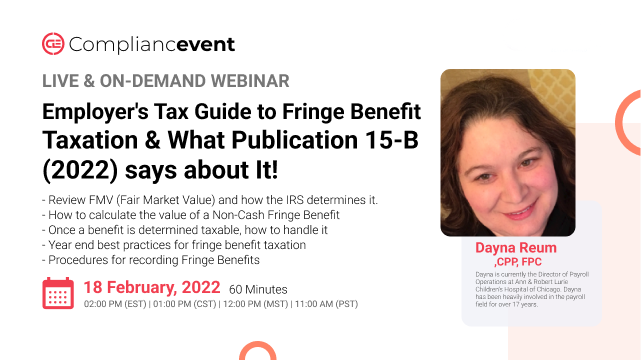- Topics
- Webinars
- Products & Services
Welcome To Biggest Online compliance Platform By LOCGFX Pvt. Ltd.
Human Resource & Payroll
Fringe benefits - often called "perks" - are a form of compensation for services beyond the employee's normal rate of pay. Companies are providing more fringe benefits to employers more than ever before, thus reducing company costs but raising employee morale.
Due to changes in both, the economy and the Internal Revenue Code and COVID-19 legislation, Fringe Benefit planning has become one of the most important areas of planning for your client’s business and personal needs. In addition, the tax reform provisions of the 2017 Jobs Creation and Tax Act (JCTA) changed the rules for a number of popular benefits. Because of this, the IRS has more to say on what Fringe Benefits are taxable and what are not. The IRS for non-taxable fringe benefits puts a lot of regulation around how the fringe benefit is given and when that also determines if a thought non-taxable item may end up being taxable. And recently released Publication 15 -B (2022) by the IRS, has a lot to say on Fringe Benefit Taxation.
This course looks at those various tools and techniques and provides the practitioner with a basic understanding of how to use each one.
-IRS rules for taxation of Fringe Benefits
-How to calculate the value of a Non-Cash Fringe Benefit
-Review FMV (Fair Market Value) and how the IRS determines it.
-Details of how the Jobs Creation and Tax Act (JCTA) impacted Fringe Benefits
-Procedures for recording Fringe Benefits
-Once a benefit is determined taxable, how to handle it
-Review of excludable Fringe Benefits
-Discussion on No additional cost services, employee discounts, working condition fringe benefits & De-minimis Fringe Benefits.
-Year-end best practices for fringe benefit taxation
-Brief overview of how to handle any fringe benefits that AP pay.
Fringe benefits are just another way of paying your employees. Do you know how to correctly track fringe benefits, as well as apply and report the various withholding tax rules for those fringe benefits? The IRS says fringe benefits must be included in, and reported as a part of employee pay, but with any good tax law, there are always exclusions to that rule. Knowing how to handle fringe benefits can be complicated, especially in an area that changes on an annual basis. And it has something new this year too with the release of Publication 15-B (2022) by the IRS. Attendees will walk away with a better understanding of what the IRS’s views and requirements are around fringe benefits, what constitutes a fringe benefit, and whether it is taxable or not. The details of the IRC exceptions allowed by the IRS will be detailed and explained to attendees. And attendees will be able to better identify and calculate the fair market value of fringe benefits for taxation purposes. Also will be covered:
-Review qualified transportation benefits, Moving/Relocation Expenses
-Discuss several excludable fringe benefits such as Retirement planning, athletic facilities, achievement awards, etc.
-Review executive taxation items, like spousal travel. Company aircraft usage etc.
-Payroll Supervisors and Personnel
-HR Supervisors and Personnel
-Public Accountants
-Internal Auditors
-Tax Compliance Officers
-Enrolled Agents
-Employee Benefits Administrators
-Officers and Managers with Tax or Benefits Compliance Oversight
-Company / Business Owners
-Managers/ Supervisors
-Public Agency Managers
-Audit and Compliance Personnel / Risk Managers

Dayna is currently the Director of Payroll Operations at Ann & Robert Lurie Children’s Hospital of Chicago. Dayna has been heavily involved in the payroll field for over 17 years. Starting as a payroll clerk at a small Tucson company, Dayna moved on to be a Payroll Team Leader at Honeywell Inc. During Dayna’s time at Honeywell she obtained her FPC (Fundamental Payroll Certification) through the American Payroll Association. She also received several merit awards for Customer Service and Acquisitions and Divestitures.
Dayna is no stranger to teaching she has taught at the Metro Phoenix American Payroll Association meetings and at the Arizona State Payroll Conference. Topics including Payroll Basics, Global/Cultural Awareness, Immigration Basics for the Payroll Professional, Multi-State and Local Taxation and Quality Control for Payroll, International and Canadian payroll. Dayna has her CPP (Certified Payroll Professional) through the APA. She also serves on the National American Payroll Association on the National Strategic Leadership Task Force, Government Affairs Task Force (PA Local tax subcommittee). Dayna has received a Citation of Merit for her service along with being a Gold Pin member of the APA. Besides her payroll accomplishments, Dayna is certified in HR hiring and firing practices and is a Six-Sigma Greenbelt.
Compliancevent Webinar Certification - Compliancevent rewards you with Compliancevent Achievement Certification for unlocking and attending this webinar. It is to acknowledge your participation in this training session and to add more to your professional score.
Compliancevent Courses and Webinars or any Education published "Articles & Materials" strictly follows the standards and guidelines of the Professional Credit / CEU Providers and Well Researched before publishment.
Compliancevent doesn't support any Fake - News, Articles, or Compliance updates; Our Industry Experts are highly verified and recognized, and their Pre-publishment is verified via our experts and fact-checkers.
Sign up now on compliancevent.net. Visit compliancevent.net/webinar to discover a wide range of webinars from industry specialists. Tick on either ‘live webinar’ or ‘on-demand’, and simply click on ‘buy now’ to get enrolled.
You can refer compliancevent to anyone in your social circle. Explore your industry with your colleagues by getting them signed up on compliancevent.net today!
Go for the topic of your keen interest on compliancevent.net. Tick on ‘live webinar’ and get enrolled! Easy registration, transparent transaction.
You can request for an on-demand webinar that records the live webinar for you. After the webinar ends, you will have full access to the webinar’s recording. You can also explore compliancevent offline to order your webinar DVDs, flash drives and transcripts.
If you can’t attend the live webinar, simply go for the ‘on-demand webinar’ for the same price! Now, the live webinar recording will be saved in a cloud storage for you to access anytime from anywhere.
compliancevent offers both hard and soft copies of the webinars. It contains all the highlights as well as comprehensive descriptions of the webinar, so you never miss out a single detail.
After attending the live webinar, your certificate will be emailed to you. You can download it and add more charm to your professional score.
At the end of each webinar, you have the opportunity to interact with your industry experts, where you will get answers to all your queries.
Can’t attend the live webinar? compliancevent has got you covered! You can always switch to the on-demand webinar from your portal. You can also get your hands on the webinar’s DVD/flash drive and transcript. So order them now!
compliancevent brings a variety of options for offline learning. Order your DVDs, flash drives or transcripts now to have a lifetime access to compliancevent webinars. You can also go for on-demand recordings. Download and watch it anytime from anywhere in the world!
